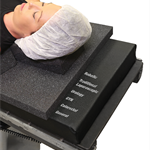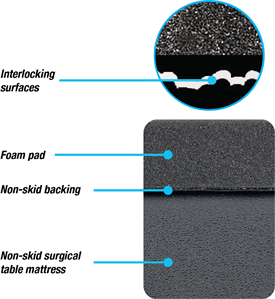The introduction of robotic surgical systems and their integration into minimally invasive procedures have changed the landscape of laparoscopic surgery dramatically. The STEEP-T™ system is quick and easy to set up. The single-use foam pad with straps may be used to gently reposition the patient on the O.R. table, as needed, for pre-operative changes.
Robotic-assisted surgery has shown advantages for laparoscopic and minimally invasive surgery. Minimally invasive surgery is meant to use precise movements with smaller incisions, less blood loss and pain, shorter hospital stays, and quicker recuperation time. Robotic instrument wrists have shown to provide these precise movements for these optimal results. There is also a 3-dimensional aspect to robotic surgery that can be controlled by technology, with a superior result
The introduction of robotic surgical systems and their integration into minimally invasive procedures have changed the landscape of laparoscopic surgery dramatically.
- From the Journal of Endourology:4
The U.S. has rapidly progressed to use this robotic concept, due to patient demands and surgeon preferences, despite the high costs. Intuitive Surgical's da Vinci Surgical System was first approved by the Food and Drug Administration for cardiothoracic procedures in the late 1990s. This trend quickly spread through other surgical specialties, with urologists as one of the frontrunners in adoption.1,2
There are four major factors that contribute to performing successful robot-assisted surgery. These include a good understanding of the procedure, superior surgical skills and training, flawless teamwork, and, most importantly, patient positioning and robotic port placement. The main goals of patient positioning and port placements are maintaining the safety of the patient, avoiding compression injuries, allowing maximum mobility of the robotic arms, and facilitating a smooth and efficient surgery. Read the full article here
With the constant improvements to patient positioning considerations in the marketing place, DeRoyal has created a new system for use with steep angulation and patient repositioning during robotic surgery. Take a look at the STEEP-T™ Multi-Angle Patient Positioning System details below.


The STEEP-T™ system provides patient fixation for any procedure that requires steep angulation of the operative table. The STEEP-T™ system is a solution for multi-specialty surgical applications. The system helps to prevent unwanted movement or slippage of the patient during table position changes as well as prolonged periods of fixed steep angulation.

The positioning system decreases the potential for complication by providing superior support and fixation for greater patient protection.
The STEEP-T™ system is quick and easy to set up. The single-use foam pad with straps may be used to gently reposition the patient on the O.R. table, as needed, for pre-operative changes.

Creating Optimal Fixation
The combination of the foam pad with corresponding non-skid backing, along with non-skid mattress pad base, provides thousands of points of extreme static grip as the two surfaces interlock.
The foam pad offers a cross-strapping configuration with handles capable of repositioning the patient on the O.R. table as needed for intubation and final surgical positioning. This feature eliminates the necessity of a sheet between the patient and the foam pad, giving 100% skin-to-foam contact for optimal fixation.
Maximize Safe Patient Handling
The STEEP-T™ system is constructed of a high-density polyurethane foam that is
cool and breathable for patient comfort. Our system components are designed to be most effective when used in unison. Each component also has several independent indications for patient positioning in multiple surgical environments.

-
Foam Positioning Pad
-
Head Positioner
-
Scapular Wedges
-
Arm Protectors
REFERENCES:
1. Intuitive S. Investor Presentation Q4 2012. October25, 2012
2. National Cancer Institute. Tracking the Rise of Robotic Surgery for Prostate Cancer. August9, 2011. Volume 8/Number 16 [
Google Scholar]
3. Tomaszewski JJ, Casella DP, Turner RM II, et al. Pediatric laparoscopic and robot-assisted laparoscopic surgery: Technical considerations. J Endourol 2012;26:602–613 [PubMed] [Google Scholar]
4. Patient Positioning and Port Placement for Robot-Assisted Surgery. J Endourol. 2014 Jun 1; 28(6): 631–638.